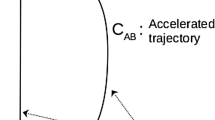Abstract
GJ 436b is a Neptune-size planet with 23.2 Earth masses in an elliptical orbit of period 2.64 days and eccentricity 0.16. With a typical tidal dissipation factor (Q′∼106) as that of a giant planet with convective envelope, its orbital circularization timescale under internal tidal dissipation is around 1 Ga, at least two times less than the stellar age (> 3 Ga). A plausible mechanism is that the eccentricity of GJ 436b is modulated by a planetary companion due to their mutual perturbation. Here we investigate this possibility from the dynamical viewpoint. A general method is given to predict the possible locations of the dynamically coupled companions, including nearby/distance non-resonant or mean motion resonance orbits with the first planet. Applying the method to GJ 436 system, we find it is very unlikely that the eccentricity of GJ 436b is maintained at the present location by a nearby/distance companion through secular perturbation or mean motion resonance. In fact, in all these simulated cases, GJ 436b will undergo eccentricity damp and orbital decay, leaving the present location within the stellar age. However, these results do not rule out the possible existence of planet companions in nearby/distance orbits, although they are not able to maintain the eccentricity of GJ 436b.
Similar content being viewed by others
References
Wolszczan A, Frail D A. A planetary system around the millisecond pulsar PSR1257+12. Nature, 1992, 355: 145–147
Mayor M, Queloz D. A Jupiter-mass companion to a Solar-type star. Nature, 1995, 378: 355–359
Udry S, Santos N C. Statistical properties of exoplanets. Annu Rev Astron Astrophys, 2007, 45: 397–439
Bennett D P, Bond I A, Udalski A, et al. A low-mass planet with a possible sub-stellar-mass host in microlensing event MOA-2007-BLG-192. Astrophys J, 2008, 684: 663–683
Butler R P, Vogt S S, Marcy G W, et al. A Neptune-mass planet orbiting the nearby M dwarf GJ 436. Astrophys J, 2004, 617: 580–588
Maness H L, Marcy G W, Ford E B, et al. The M dwarf GJ 436 and its Neptune-mass planet. Publ Astron Soc Pac, 2007, 119: 90–101
Gillon M, Demory B O, Barman T, et al. Accurate spitzer infrared radius measurement for the hot Neptune GJ 436b. Astron Astrophys, 2007, 471: L51–L54
Gillon M, Pont F, Demory B O, et al. Detection of transits of the nearby hot Neptune GJ 436b. Astron Astrophys, 2007, 472: L13–L16
Deming D, Harrington J, Laughlin G, et al. Spitzer transit and secondary eclipse photometry of GJ 436b. Astrophys J, 2007, 667: L199–L202
Demory B O, Gillon M, Barman T, et al. Characterization of the hot Neptune GJ 436b with spitzer and ground-based observations. Astron Astrophys, 2007, 475: 1125–1129
Torres G. The transiting exoplanet host star GJ 436: A test of stellar evolution models in the lower main sequence, and revised planetary parameters. Astrophys J, 2007, 671: L65–L68
Bean J L, Benedict G F, Charbonneau D, et al. A Hubble space telescope transit light curve for GJ 436b. Astron Astrophys, 2008, 486: 1039–1046
Shporer A, Mazeh T, Winn J N, et al. Photometric follow-up observations of the transiting Neptune-mass planet GJ 436b. 2008, arXiv: 0805.3915
Ribas I, Font-Ribera A, Beaulieu J P. A ∼ 5M ⊕ super-earth orbiting GJ 436? The power of near-grazing transits. Astrophys J, 2008, 677: L59–L62
Mardling R A. On the long-term tidal evolution of GJ 436b in the presence of a resonant companion. 2008, arXiv: 0805.1928
Coughlin J L, Stringfellow G S, Becker A C, et al. New observations and a possible detection of parameter variations in the transits of Gliese 436b. 2008, arXiv: 0809.1664
Marcy G W, Butler R P. Detection of extrasolar giant planets. Annu Rev Astron Astrophy, 1998, 36: 57–98
Marchal C, Bozis G. Hill stability and distance curves for the general three-body problem. Cele Mech, 1982, 26: 311–333
Gladman B. Dynamics of systems of two close planets. Icarus, 1993, 106: 247–263
Goldreich P, Soter S. Q in the solar system. Icarus, 1966, 5: 375–389
Murray C D, Dermott S F. Solar System Dynamics. Cambridge: Cambridge University Press, 1999
Eggleton P P, Kiseleva L G, Hut P. The equilibrium tide model for tidal friction. Astrophys J, 1998, 499: 853–870
Mardling R A, Lin D N C. Calculating the tidal, spin, and dynamical evolution of extrasolar planetary systems. Astrophys J, 2002, 573: 829–844
Dobbs-Dixon I, Lin D N C, Mardling R A. Spin-orbit evolution of short-period planets. Astrophys J, 2004, 610: 464–476
Zhou J L, Lin D N C. Migration and final location of hot super earths in the presence of gas giants. In: Sun Y-S, Ferraz-Mello S, Zhou J-L, eds. Proc of IAU Symp 249: Exoplanets: Detection, Formation and Dynamics. Cambridge: Cambridge University Press, 2008. 285–291
Mardling R A. Long-term tidal evolution of short-period planets with companions. Mon Not Roy Astron Soc, 2007, 382: 1768–1790
Beauge C, Michtchenko T A. Modelling the high-eccentricity planetary three-body problem. Application to the GJ876 planetary system. Mon Not Roy Astron Soc, 2003, 341: 760–770
Laskar J. NATO Advanced Study Institute on Predictability, Stability, and Chaos in N-Body Dynamical Systems. Roy A E, ed. New York: Plenum Press, 1991, 93–114
Author information
Authors and Affiliations
Corresponding author
Additional information
Supported by the National Natural Science Foundation of China (Grant Nos. 10833001 and 10778603) and the National Basic Research Program of China (Grant No. 2007CB4800)
Rights and permissions
About this article
Cite this article
Tong, X., Zhou, J. Eccentricity modulation of a close-in planet by a companion: Application to GJ 436 system. Sci. China Ser. G-Phys. Mech. Astron. 52, 640–648 (2009). https://doi.org/10.1007/s11433-009-0070-9
Received:
Accepted:
Published:
Issue Date:
DOI: https://doi.org/10.1007/s11433-009-0070-9




